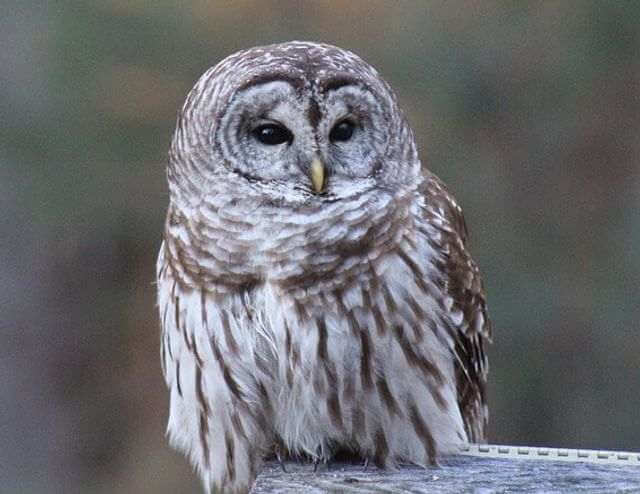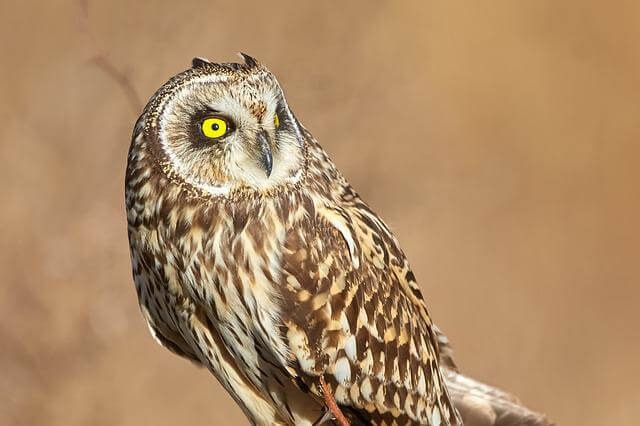In 2023, there are nine species of owls in Tennessee. These owls can be found in different parts of the state throughout the year, but the best time to see them is during the winter, when they are most active. The following is a list of the owl species and their corresponding frequencies.
Table of Contents
Species of Owls in Tennessee
Barred Owl
- Length: 16.9-19.7″ in (43-50 cm)
- Weight: 16.6-37.0 oz. (470-1050 g)
- Wingspan: 39.0-43.3″ in (99-110 cm)
- Scientific Name: Strix varia
- Frequency of Occurrence: 2.74% (Statistic by: eBird)
- Where To Find Them: Barred owls can be found in a number of different areas throughout Tennessee. They are most commonly found in the eastern part of the state, but can also be found in other areas. Some good places to look for barred owls include the Great Smoky Mountains National Park and Chickamauga and Chattanooga National Military Park.
- How to Attract: One way to attract barred owls to your yard is to provide them with a place to roost. You can do this by installing a nesting box or platform. Barred owls will also use tree cavities for nesting, so make sure you have plenty of trees in your yard. They can also attracted to your yard if there is an abundance of prey animals such a mice.
General Information: The barred owl is a common inhabitant of eastern and central North America. It ranges from southern Canada to central Mexico, and from the Atlantic coast to the Great Plains. The barred owl prefers dense forests near waterways, but it can also be found in open woodland, parks, and suburbs.
Its diet consists mainly of small mammals, but it also eats birds, reptiles, amphibians, and insects. The barred owl nests in tree cavities, usually those made by other animals.
Great Horned Owl

- Length: 18.1-24.8 in (46-63 cm)
- Weight: 32.1-88.2 oz. (910-2500 g)
- Wingspan: 39.8-57.1 in (101-145 cm)
- Scientific Name: Bubo virginianus
- Frequency of Occurrence: 0.8989%
- Where To Find Them: The best place to see great horned owls in Tennessee is probably the Great Smoky Mountains National Park. These owls can also be found in other parts of the state, including the Cumberland Plateau and the eastern part of the state.
- How to Attract: Suburban and rural areas offer ample opportunities for hunting. The open spaces provide good visibility for spotting prey, while the presence of trees and other vegetation provides good cover for stalking prey. Lawns, gardens, and birdfeeders also attract small mammals and birds that make easy targets for Great Horned Owls. Another factor that may attract Great Horned Owls to yards is the availability of roosting sites.
General Information: Great Owl Owls are among the most widespread owl types. They can reside in North and South America, Europe, Asia, and North Africa. In the United States, they can be found in every state except for Hawaii. Great Horned Owls inhabit a wide variety of habitats, including forests, deserts, wetlands, and urban areas.
They are mostly nocturnal and hunt rodents, rabbits, birds, and other small prey. Great Horned Owls build nests in trees or on cliffs. They lay 2-4 eggs which hatch after about 28 days.
Related Post: 35 Fun Facts About The Great Horned Owl (Detailed)
Eastern Screech-owl
- Length: 6.3-9.8″ in (16-25 cm)
- Weight: 4.3-8.6 oz. (121-244 g)
- Wingspan: 18.9-24.0″ in (48-61 cm)
- Scientific Name: Megascops asio
- Frequency of Occurrence: 0.8550%
- Where To Find Them: Some of the best places to find them include the Smokey Mountains, the Chickamauga and Chattanooga National Military Park, and the Big South Fork National River and Recreation Area.
- How to Attract: These owls are attracted to yards that have dense vegetation and a lot of trees. They use the dense vegetation to hide from predators and to find prey. Eastern screech-owls also use trees for perching and nesting. If you want to attract eastern screech-owls to your yard, you should provide a habitat that is similar to their natural habitat.
General Information: Eastern screech-owls are found in North America and are a common sight in the eastern United States. These owls can be found in a variety of habitats, including forests, woodlands, and even parks.
They typically live in trees, but can also be seen on the ground or on buildings. Eastern screech-owls hunt at night and eat a variety of small animals, such as rodents, insects, and other birds. They build nests out of sticks and lay 2-6 eggs.
Barn Owl
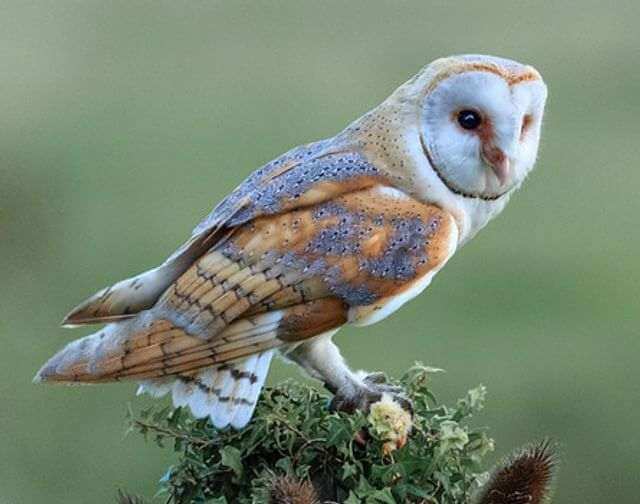
- Length: 12.6-15.8″ in (32-40 cm)
- Weight: 14.1-24.7 oz. (400-700 g)
- Wingspan: 39.4-49.2″ in (100-125 cm)
- Scientific Name: Tyto alba
- Frequency of Occurrence: 0.1511%
- Where To Find Them: The best places to see them are typically in open areas with plenty of perches and rodents. Some good locations include the Cumberland Plateau, the Great Smoky Mountains, and the lower Tennessee River Valley.
- How to Attract: There are a few things you can do to attract barn owls to your yard. One is to provide a perching spot for them, such as a tall tree or a wooden post. You can also install a nest box if there aren’t any trees nearby. And finally, make sure there are plenty of small prey animals available for them to hunt.
General Information: The barn owl (Tyto alba) is a common sight in North America, where it ranges from central Canada to northern Mexico. This species is also found in Europe, Asia, and Africa. The barn owl prefers open areas with scattered trees or buildings, where it can find prey.
It feeds mainly on small mammals such as mice, voles, and rats, but will also eat birds, insects, and reptiles. Barn owls nest in holes in trees or buildings, sometimes using old hawk or squirrel nests. An average clutch contains four to six eggs.
Short-eared Owl
- Length: 13.4-16.9 in (34-43 cm)
- Weight: 7.3-16.8 oz. (206-475 g)
- Wingspan: 33.5-40.5 in (85-103 cm)
- Scientific Name: Asio flammeus
- Frequency of Occurrence: 0.1111%
- Where To Find Them: In Tennessee, the best places to find short-eared owls include Big Cypress National Preserve, the Great Smoky Mountains National Park, and the Catoosa Wildlife Management Area.
- How to Attract: The Short-eared Owl is attracted to open areas with plenty of small rodents to hunt. If you have a yard that is open and has a good population of mice, rats, or voles, you may have a chance at attracting these owls. They are also attracted to areas near water where they can find small fish to eat. If you have a pond or large creek in your yard, this could be the perfect spot for an owl sighting.
General Information: Short-eared owls are a medium-sized owl species that is found in North America, Europe, and Asia. The short-eared owl is a diurnal owl species which means they are active during the day. These owls are usually found in open habitats such as prairies, meadows, and fields.
They can also be found in marshes, bogs, and other wetland areas. These owls feed mainly on small mammals such as rodents, but they will also eat birds, reptiles, and insects. Short-eared owls usually nest on the ground in an open area such as a meadow or prairie.
Snowy Owl
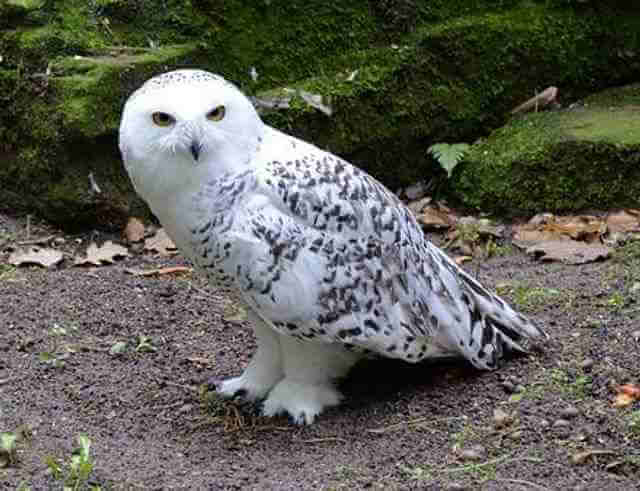
- Length: 20.5-27.9 in (52-71 cm)
- Weight: 56.4-104.1 oz. (1600-2950 g)
- Wingspan: 49.6-57.1 in (126-145 cm)
- Scientific Name: Bubo scandiacus
- Frequency of Occurrence: 0.0219%
- Where To Find Them: The Snowy Owl is a beautiful bird that can be found in many different areas around Tennessee. One of the best places to find them is in the Great Smoky Mountains National Park. They can also be found in other areas around the state such as Cades Cove, the Cumberland Plateau, and the Nashville area.
- How to Attract: Snowy owls are experts at hunting small mammals, so if you have a lot of mice or rats running around, the owl will likely be attracted to your property. Second, provide a place for the owl to perch. A tall tree or pole near where the owl is feeding will give it a good vantage point from which to watch for prey. Finally, offer some water for the owl to drink.
General Information: Snowy owls are one of the most beautiful and interesting birds in North America. They are large, with a wingspan of up to five feet, and they have stunningly white plumage. Snowy owls inhabit tundra and open country in the Arctic, where they prey on small mammals such as lemmings and voles.
They also eat birds and fish. Snowy owls build nests out of sticks, feathers, and other materials, typically on the ground near a hill or other elevated spot that offers good visibility. Females lay one to five eggs at a time, which both parents help to incubate. Young snowy owls fledge after about six weeks.
Related Post: 48 Fun Facts About Snowy Owls (with Photos, ID & Info)
Northern Saw-whet Owl
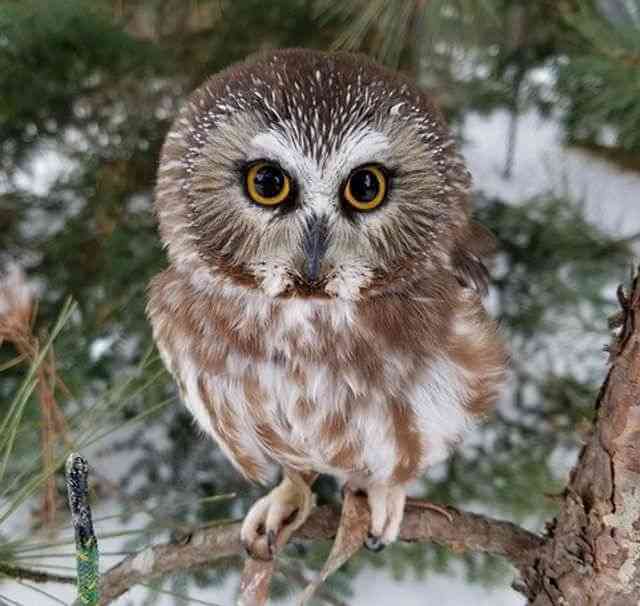
- Length: 7.1-8.3 in (18-21 cm)
- Weight: 2.3-5.3 oz. (65-151 g)
- Wingspan: 16.5-18.9 in (42-48 cm)
- Scientific Name: Aegolius acadicus
- Frequency of Occurrence: 0.0183%
- Where To Find Them: There are several places in Tennessee where you can see Northern Saw-whet Owls. One of the best places is Great Smoky Mountains National Park. The park has a large forested area where the owls can be found. Other good places to see them include Chickamauga and Chattanooga National Military Park, Cherokee National Forest, and Big South Fork National River and Recreation Area.
- How to Attract: The Northern Saw-whet Owl is a small owl that is attracted to yards that have dense vegetation. They like to find a perch in a tree and scan the area for prey. They are most active at night, but are occasionally seen during the day. The best way to attract these owls to your yard is by providing them with a place to perch and by keeping your yard free of predators.
General Information: The Northern Saw-whet Owl is the smallest owl in North America. They are found in coniferous and deciduous forests across Canada, Alaska, and the northern United States. The Northern Saw-whet Owl’s diet consists of mostly small mammals such as mice, voles, and shrews.
They also eat insects and other small invertebrates. These owls nest in tree cavities or abandoned nests of other birds. The female typically lays 4-5 eggs, which are incubated by both parents for about 27 days. Once the chicks hatch, the parents continue to feed them until they are able to fly from the nest around six weeks old.
Related Post: What is the Smallest Owl in North America?
Long-eared Owl
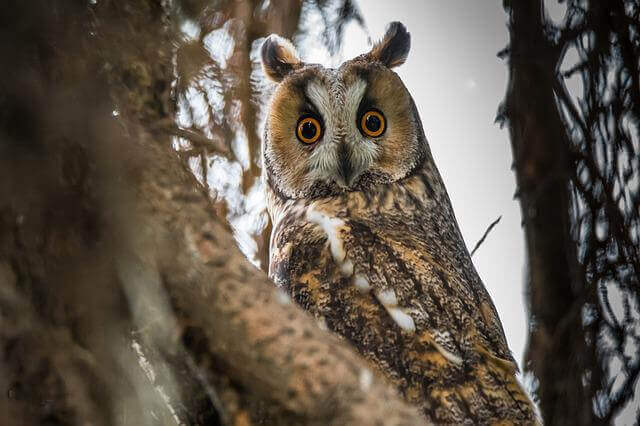
- Length: 13.8-15.8 in (35-40 cm)
- Weight: 7.8-15.3 oz. (220-435 g)
- Wingspan: 35.4-39.4 in (90-100 cm)
- Scientific Name: Asio otus
- Frequency of Occurrence: 0.0094%
- Where To Find Them: The best places to find them include the Great Smoky Mountains National Park, the Cherokee National Forest, and the Big South Fork National River and Recreation Area.
- How to Attract: The Long-eared Owl is a nocturnal bird that can often be seen around yards and fields. One of the things that may attract them to your yard is if you have a lot of rodents, which they prey on. They are also attracted to areas with dense cover, such as shrubs and trees. If you have these features in your yard, you may be more likely to see a Long-eared Owl.
General Information: The Long-eared Owl is a medium-sized owl that ranges in length from 14-16″ inches and has a wingspan of 35-39″ inches. The Long-eared Owl is the most widespread owl in North America and can be found in a variety of habitats including forests, agricultural areas, and even deserts.
They are typically nocturnal predators, feeding mainly on small rodents such as mice, voles, and rats. They also consume other small mammals, birds, reptiles, and insects. The Long-eared Owl nests in tree cavities or old hawk or raven nests, laying 2-6 eggs per clutch.
Burrowing Owl
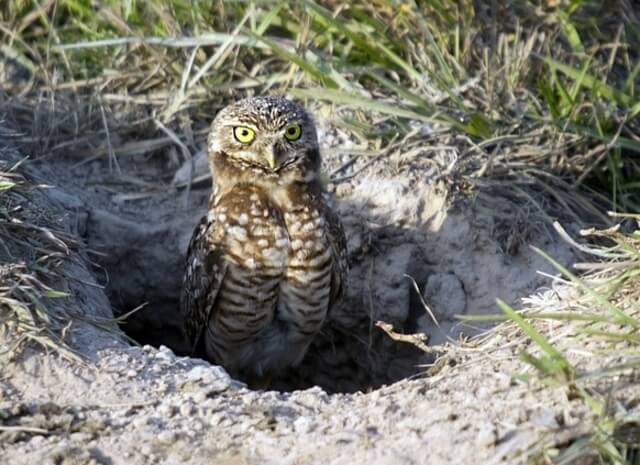
- Length: 7.5-9.8″ in (19-25 cm)
- Weight: 5.3 oz. (150 g)
- Wingspan: 21.6″ in (55 cm)
- Scientific Name: Athene cunicularia
- Frequency of Occurrence: 0.0027%
- Where To Find Them: The best places to find these owls in Tennessee include the Cumberland Plateau, the Highland Rim, and the Western Coal Fields.
- How to Attract: These owls are attracted to yards that offer them a few key things: tall grass for nesting, a water source, and plenty of rodents to eat. If you can provide these things in your yard, you may be lucky enough to have a Burrowing Owl or two visit you!
General Information: The Burrowing Owl is a small, brown owl that can be found throughout North and South America. They live in open areas near prairies, grasslands, and deserts. These owls prefer to live in abandoned rodent burrows, but they will also make their own nests in trees or on the ground.
Burrowing Owls eat a variety of creatures such as rodents, snakes, lizards, amphibians, and insects. In the summer, they also eat fruits and berries. Most of the time, these owls are monogamous and stay together for life. The female Burrowing Owl typically lays 2-4 eggs, which both parents help to incubate for about 28 days.
Related Post: Really Cool Burrowing Owl Facts That Will Amaze You!


